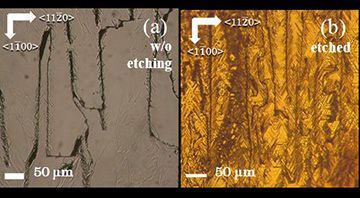
In addition to large grooves, which were present before etching, high density of small grooves was observed on the surfaces after etching. [Image: NITech]
Splitting water to produce pure hydrogen could be a game changer in the quest for sustainable energy. Current water-splitting methods that use solar irradiation of TiO2 electrodes, however, do not produce hydrogen efficiently because solar absorption by the electrodes is limited. Hydrogen can be produced in bulk from fossil fuels, but this necessitates release of carbon dioxide.
Now, researchers at Nagoya Institute of Technology, Japan, have used electrochemical etching of silicon-carbide (SiC) photoelectrodes, and a platinum cocatalyst, to obtain what they claim are record efficiencies (App. Phys. Exp. doi: 10.35848/1882-0786/ab6f29).
Electrochemical etching
Because of its durability, SiC is one of the most promising photoelectrode materials, the researchers, led by Masashi Kato, write. For their work, the researchers used 3C-SiC photocathodes with a Pt cocatalyst because these show a relatively high solar-to-hydrogen conversion efficiency of 0.72%. But, they write, there was room for improvement.
One method to improve solar cell efficiencies—that is, an increase in absorbed solar light—is to form a texture structure on the surface of the solar cell materials. Forming texture structures to improve the performance of photoelectrodes, the researchers reason, is applicable in the same way. The rugged surface allows light to pass through the photoelectrode material multiple times, increasing the amount of sunlight absorbed.
Avoiding point defects
However, point defects on the photoelectrode must be avoided. The Nagoya team ruled out a previously reported method—reactive ion etching—for just this reason. Instead, the team used electrochemical etching with a potassium hydroxide solution to form texture structures on the electrodes. The researchers used electrochemical deposition to form the Pt cocatalyst particles—a hydrogen-conversion performance enhancer also improved by the texture structures.
The research team etched the electrodes under various conditions and compared optical and electrical properties. The team also imaged the etched electrodes in detail to see how the textured surfaces occurred preferentially along faults and dislocations on the material’s surface.
Under optimal conditions of etching and cocatalyst deposition, the researchers report an applied bias photon-to-current conversion efficiency (ABPE) of 2%.
“This ABPE value is the highest value compared to reported efficiencies for SiC photoelectrodes so far,” they write. They call the results “promising for solar-to-hydrogen energy conversion applications.”
